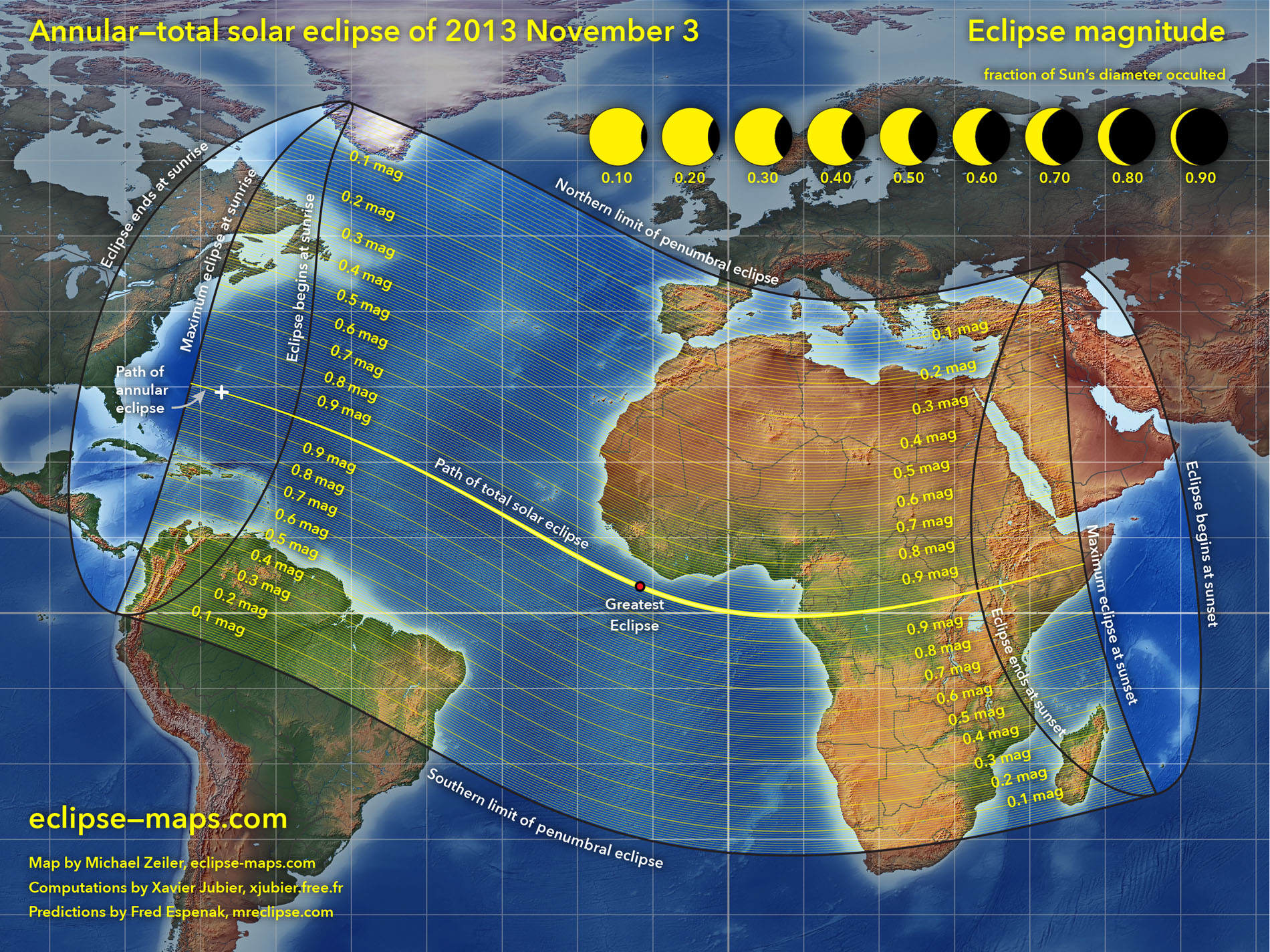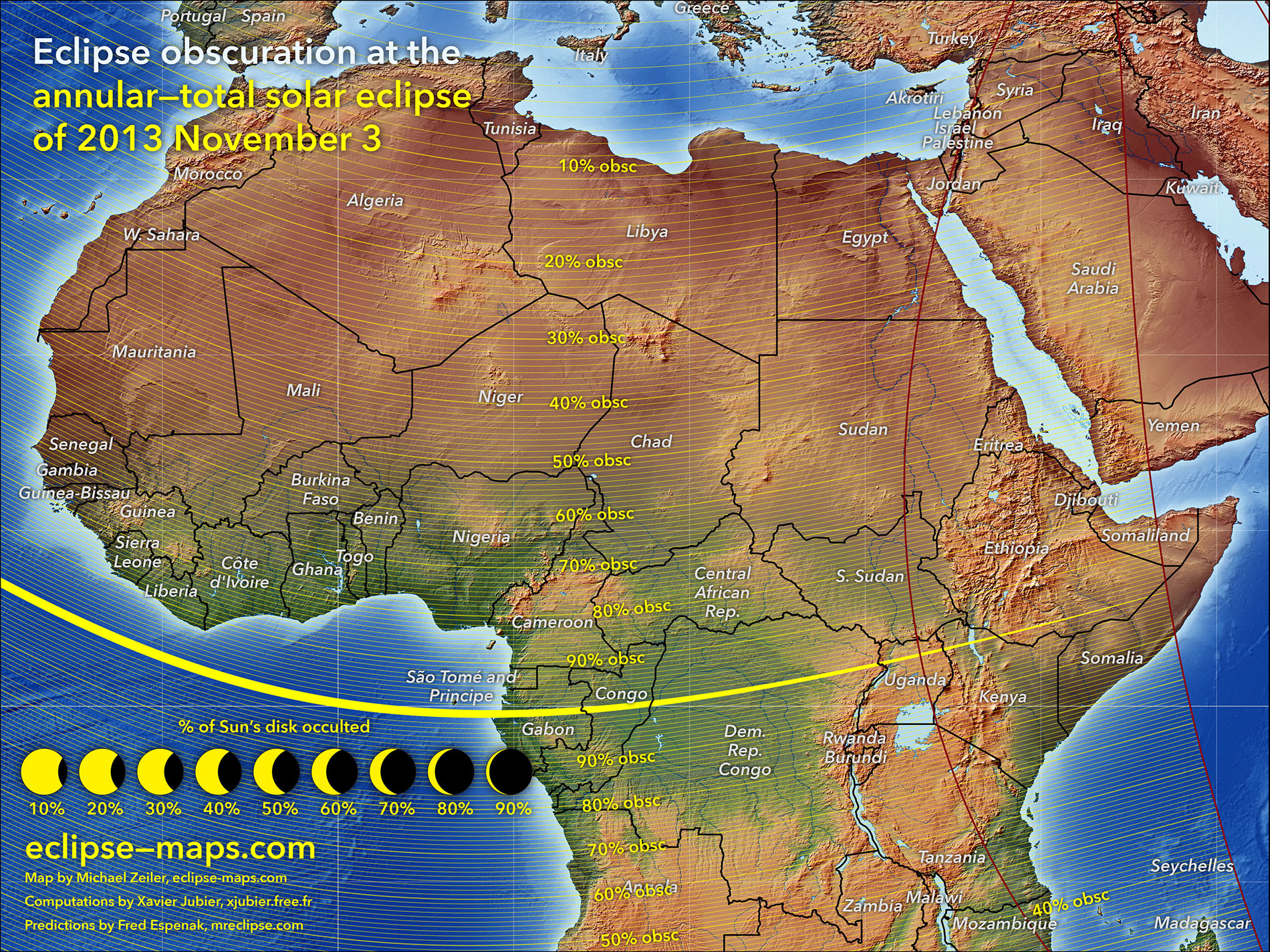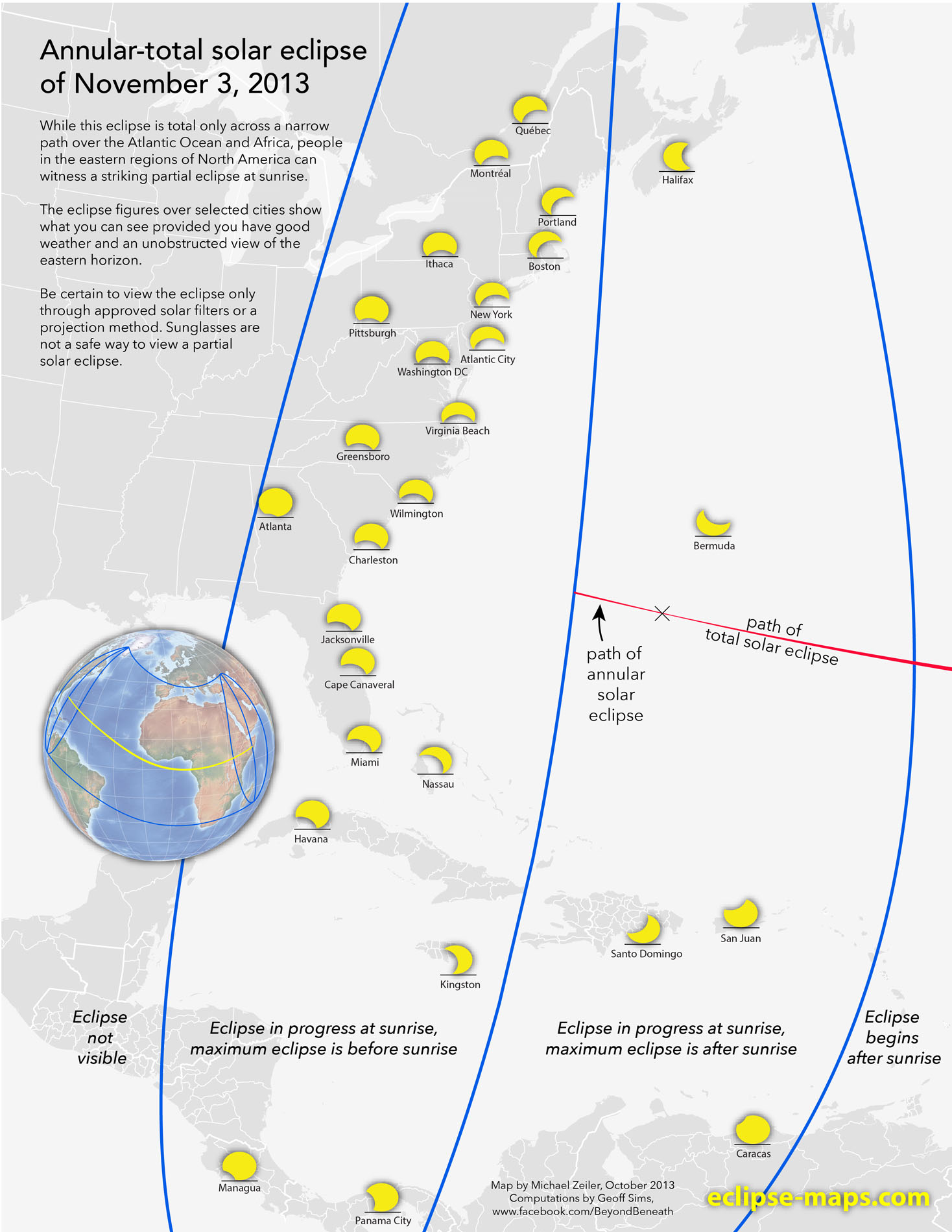Rare Hybrid Solar Eclipse Occurs Today: Watch It Live Online

Editor's Note: See the first photos and accounts of Sunday's solar eclipse by eclipse chasers here: Rare Solar Eclipse Wows Skywatchers Across Atlantic, Africa (Photos)
The moon and sun will team up to create a rare event Sunday (Nov. 3): a hybrid solar eclipse that could amaze eclipse chasers across eastern North America, the Atlantic Ocean and Africa. But you don't have to hop on a plane to see the celestial spectacle — you can watch it live online.
The online Slooh community observatory will provide a free webcast of Sunday's hybrid solar eclipse beginning at 6:45 a.m. EDT (1145 GMT). Slooh host Paul Cox will provide live views of the eclipse from the Kenya countryside in Africa, with other feeds expected from Gabon, Africa, and the Canary Islands off Africa's western coast. Meanwhile, a partial solar eclipse will be visible from the U.S. East Coast and parts of Canada, as well as southern Europe and most of Africa, weather permitting.
You can watch the solar eclipse webcast live on SPACE.com, courtesy of Slooh. The last hybrid solar eclipse occurred in April 2005 and it won't occur again until 2023. [How to See Sunday's Solar Eclipse]
"This will be the most difficult eclipse we've covered at Slooh over the years," Cox said in a statement. "Our expedition will be made in a series of 4x4 vehicles carrying our delicate observation equipment across some of the harshest terrain in Africa." You can also watch the webcast live on Slooh.com and via Slooh's iPad and iPhone app.

Solar eclipses occur when the moon is between the sun and Earth and appears to block the sun as seen from Earth's surface. When the moon and sun align perfectly, it creates a total solar eclipse. Partial solar eclipses occur when the moon covers only part of the sun's disk, while annular eclipses — also known as "ring of fire" solar eclipses — occur when the moon's shadow falls short of the Earth's surface, leaving a bright ring of sunlight around its edges.
Sunday's hybrid solar eclipse will be at its best along a narrow strip of the Earth that begins in the mid-Atlantic Ocean and stretches across into Central Africa. This path of annularity and totality marks where the maximum eclipse can be seen from, with several eclipse-chasing expeditions by ship and aircraft planned for the ocean-bound portion.
Get the Space.com Newsletter
Breaking space news, the latest updates on rocket launches, skywatching events and more!
One such expedition, led by astronomer Jay Pasachoff of Williams College, will be in Gabon, Africa, where the total solar eclipse will make landfall. The moon's shadow will then continue across Africa, passing through the Congos, northern Uganda, and northern Kenya. It will end in southern Ethiopia and Somalia.Cartographer Michael Zeiler of Eclipse-Maps.com has created a series of maps showing the path and schedule of Sunday's solar eclipse.
During the Slooh webcast, which is expected to last four hours, Cox will interview astronomy and eclipse experts to discuss the solar spectacle. Webcast viewers can submit questions by email at coxy@slooh.com and via the hashtag #solareclipse.
"I'm looking forward to interviewing our line-up of expert guests throughout the live broadcast; we'll discuss just about every aspect of these awe-inspiring celestial events, and also explain why this particular eclipse is of the rare 'hybrid' variety," Cox said.

For observers on the eastern coast of North America, Sunday's eclipse will be a partial solar eclipse that begins at sunrise. If weather permits, early-bird amateur astronomers will see the sun rise with a piece missing.
Warning: Never look directly at the sun, either with the naked eye or through telescopes or binoculars without the proper filters. Serious and permanent eye damage can occur, including blindness. Astronomers and amateur eclipse chasers use special eclipse glasses and filters to safely observe the sun.
Editors of the astronomy magazine Sky & Telescope advises skywatchers to look to the east at 6:30 a.m. local time from an observing location with a clear eastern horizon. The partial solar eclipse will be visible for about 45 minutes, with observers from Boston to New York City seeing the sun 50-percent obscured while observers from Washington, D.C., to Miami will see the sun 47-percent obscured.
An extremely small partial solar eclipse, in which the sun looks like it has a nick missing, may even be visible from southern Ontario, Ohio, Kentucky, Tennessee, Alabama and the Florida Panhandle.
Editor's note: If you snap an amazing photo of Sunday's solar eclipse or any other celestial sight that you'd like to share for a possible story or image gallery, please contact managing editor Tariq Malik at spacephotos@space.com.
Email Tariq Malik at tmalik@space.com or follow him @tariqjmalik and Google+. Follow us @Spacedotcom, Facebook and Google+. Original article on SPACE.com.
Join our Space Forums to keep talking space on the latest missions, night sky and more! And if you have a news tip, correction or comment, let us know at: community@space.com.

Tariq is the Editor-in-Chief of Space.com and joined the team in 2001, first as an intern and staff writer, and later as an editor. He covers human spaceflight, exploration and space science, as well as skywatching and entertainment. He became Space.com's Managing Editor in 2009 and Editor-in-Chief in 2019. Before joining Space.com, Tariq was a staff reporter for The Los Angeles Times covering education and city beats in La Habra, Fullerton and Huntington Beach. In October 2022, Tariq received the Harry Kolcum Award for excellence in space reporting from the National Space Club Florida Committee. He is also an Eagle Scout (yes, he has the Space Exploration merit badge) and went to Space Camp four times as a kid and a fifth time as an adult. He has journalism degrees from the University of Southern California and New York University. You can find Tariq at Space.com and as the co-host to the This Week In Space podcast with space historian Rod Pyle on the TWiT network. To see his latest project, you can follow Tariq on Twitter @tariqjmalik.









